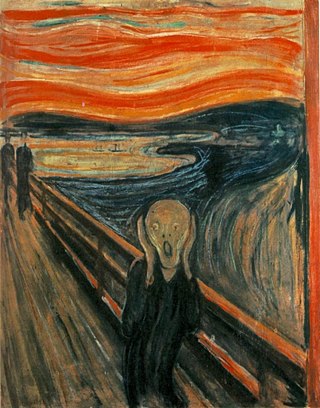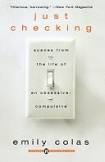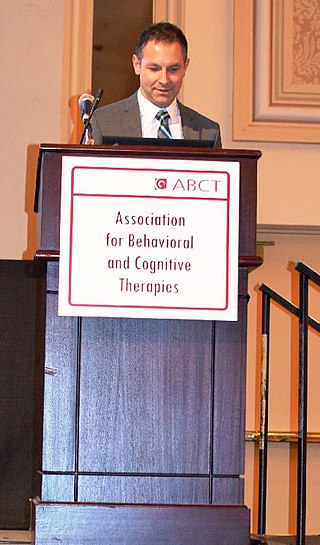Related Research Articles

Anxiety disorders are a group of mental disorders characterized by significant and uncontrollable feelings of anxiety and fear such that a person's social, occupational, and personal functions are significantly impaired. Anxiety may cause physical and cognitive symptoms, such as restlessness, irritability, easy fatigue, difficulty concentrating, increased heart rate, chest pain, abdominal pain, and a variety of other symptoms that may vary based on the individual.

Hypochondriasis or hypochondria is a condition in which a person is excessively and unduly worried about having a serious illness. Hypochondria is an old concept whose meaning has repeatedly changed over its lifespan. It has been claimed that this debilitating condition results from an inaccurate perception of the condition of body or mind despite the absence of an actual medical diagnosis. An individual with hypochondriasis is known as a hypochondriac. Hypochondriacs become unduly alarmed about any physical or psychological symptoms they detect, no matter how minor the symptom may be, and are convinced that they have, or are about to be diagnosed with, a serious illness.

Obsessive–compulsive personality disorder (OCPD) is a cluster C personality disorder marked by a spectrum of obsessions with rules, lists, schedules, and order, among other things. Symptoms are usually present by the time a person reaches adulthood, and are visible in a variety of situations. The cause of OCPD is thought to involve a combination of genetic and environmental factors, namely problems with attachment.

Hoarding disorder (HD) or Plyushkin's disorder is a mental disorder characterised by persistent difficulty in parting with possessions and engaging in excessive acquisition of items that are not needed or for which no space is available. This results in severely cluttered living spaces, distress, and impairment in personal, family, social, educational, occupational, or other important areas of functioning. Excessive acquisition is characterized by repetitive urges or behaviours related to amassing or buying property. Difficulty discarding possessions is characterized by a perceived need to save items and distress associated with discarding them. Accumulation of possessions results in living spaces becoming cluttered to the point that their use or safety is compromised. It is recognised by the eleventh revision of the International Classification of Diseases (ICD-11) and the Diagnostic and Statistical Manual of Mental Disorders, 5th edition (DSM-5).
Scrupulosity is the pathological guilt and anxiety about moral issues. Although it can affect nonreligious people, it is usually related to religious beliefs. It is personally distressing, dysfunctional, and often accompanied by significant impairment in social functioning. It is typically conceptualized as a moral or religious form of obsessive–compulsive disorder (OCD). The term is derived from the Latin scrupus, a sharp stone, implying a stabbing pain on the conscience. Scrupulosity was formerly called scruples in religious contexts, but the word scruple now commonly refers to a troubling of the conscience rather than to the disorder.

An intrusive thought is an unwelcome, involuntary thought, image, or unpleasant idea that may become an obsession, is upsetting or distressing, and can feel difficult to manage or eliminate. When such thoughts are paired with obsessive–compulsive disorder (OCD), Tourette syndrome (TS), depression, body dysmorphic disorder (BDD), and sometimes attention deficit hyperactivity disorder (ADHD), the thoughts may become paralyzing, anxiety-provoking, or persistent. Intrusive thoughts may also be associated with episodic memory, unwanted worries or memories from OCD, post-traumatic stress disorder (PTSD), other anxiety disorders, eating disorders, or psychosis. Intrusive thoughts, urges, and images are of inappropriate things at inappropriate times, and generally have aggressive, sexual, or blasphemous themes.
Sexual obsessions are persistent and unrelenting thoughts about sexual activity. In the context of obsessive-compulsive disorder (OCD), these are extremely common, and can become extremely debilitating, making the person ashamed of the symptoms and reluctant to seek help. A preoccupation with sexual matters, however, does not only occur as a symptom of OCD, they may be enjoyable in other contexts.

Edna Foa is an Israeli professor of clinical psychology at the University of Pennsylvania, where she serves as the director of the Center for the Treatment and Study of Anxiety. Foa is an internationally renowned authority in the field of psychopathology and treatment of anxiety. She approaches the understanding and treatment of mental disorders from a cognitive-behavioral perspective.
Exposure therapy is a technique in behavior therapy to treat anxiety disorders. Exposure therapy involves exposing the patient to the anxiety source or its context. Doing so is thought to help them overcome their anxiety or distress. Numerous studies have demonstrated its effectiveness in the treatment of disorders such as generalized anxiety disorder (GAD), social anxiety disorder (SAD), obsessive-compulsive disorder (OCD), post-traumatic stress disorder (PTSD), and specific phobias.
Racing thoughts refers to the rapid thought patterns that often occur in manic, hypomanic, or mixed episodes. While racing thoughts are most commonly described in people with bipolar disorder and sleep apnea, they are also common with anxiety disorders, obsessive–compulsive disorder (OCD), and other psychiatric disorders such as attention deficit hyperactivity disorder (ADHD). Racing thoughts are also associated with sleep deprivation, hyperthyroidism, and the use of amphetamines.
Primarily obsessional obsessive–compulsive disorder, also known as purely obsessional obsessive–compulsive disorder, is a lesser-known form or manifestation of OCD. It is not a diagnosis in the DSM-5. For people with primarily obsessional OCD, there are fewer observable compulsions, compared to those commonly seen with the typical form of OCD. While ritualizing and neutralizing behaviors do take place, they are mostly cognitive in nature, involving mental avoidance and excessive rumination. Primarily obsessional OCD takes the form of intrusive thoughts often of a distressing, sexual, or violent nature.

Obsessive–compulsive disorder (OCD) is a mental and behavioral disorder in which an individual has intrusive thoughts and feels the need to perform certain routines (compulsions) repeatedly to relieve the distress caused by the obsession, to the extent where it impairs general function.
Stanley Jack Rachman was a South African-born psychologist who worked primarily with obsessive-compulsive disorder (OCD) and other anxiety disorders. He spent much of his career based in the UK and Canada.

Just Checking by Emily Colas is an account of her experience with obsessive-compulsive disorder. Divided into four sections, Colas provides snapshots of her life in a journal like manner. The text conveys her emotions regarding the disease throughout her entire life including her childhood and her role as a mother herself.
In psychology, relationship obsessive–compulsive disorder (ROCD) is a form of obsessive–compulsive disorder focusing on close intimate relationships. Such obsessions can become extremely distressing and debilitating, having negative impacts on relationships functioning.
The University of Florida Obsessive–Compulsive Disorder Program is a treatment and research clinic in the Department of Psychiatry at the University of Florida. The clinic is located in Gainesville, Florida.
Joseph Zohar is the director of Psychiatry and the Anxiety and Obsessive Compulsive Clinic at the Sheba Medical Center in Tel HaShomer and professor of psychiatry at Tel Aviv University, Israel. He is the founder of the World Council on Anxiety as well as the Israeli Consortium on PTSD. He currently leads the chief installation of the Israeli Defense Force for the treatment of PTSD. He was a longtime member of the executive committee of the European College of Neuropsychopharmacology, of which he is a former president, and chairman of the Expert Platform on Mental Health.

Jonathan Stuart Abramowitz is an American clinical psychologist and Professor in the Department of Psychology and Neuroscience at the University of North Carolina at Chapel Hill (UNC-CH). He is an expert on obsessive-compulsive disorder (OCD) and anxiety disorders whose work is highly cited. He maintains a research lab and currently serves as the Director of the UNC-CH Clinical Psychology PhD Program. Abramowitz approaches the understanding and treatment of psychological problems from a cognitive-behavioral perspective.
John Piacentini, PhD, ABPP, is an American clinical child and adolescent psychologist, and professor of psychiatry and biobehavioral sciences at the David Geffen School of Medicine at UCLA in Los Angeles, California. He is the director of the Center for Child Anxiety, Resilience, Education and Support (CARES), and the Child OCD, Anxiety and Tic Disorders Program at UCLA's Semel Institute for Neuroscience and Human Behavior.
References
- ↑ Scutti, Susan. "Adele opens up about her postpartum depression". CNN. Archived from the original on 24 March 2018. Retrieved 23 March 2018.
- ↑ "Adele emotionally explains why she may never tour again". Stylist. 28 March 2017. Archived from the original on 24 March 2018. Retrieved 23 March 2018.
- ↑ McNeil, Liz (26 February 2020). "Ben Affleck on Why He Drank: 'It Was Something I Was Doing to Avoid Painful Feelings'". People . Retrieved 26 February 2020.
- ↑ Peters, Mitchell (18 April 2020). "Fiona Apple Talks Secret Marriage, Anxiety, Friendship With Cara Delevingne & More". Billboard. Retrieved 27 November 2023.
- 1 2 Barr, Sabrina (6 February 2019). "Cardi B and Missy Elliott help to destigmatise anxiety with candid Twitter exchange". The Independent .
- ↑ https://www.cheatsheet.com/entertainment/alec-baldwin-learned-cope-ocd.html/
- ↑ Gloria Goodwin (23 January 2013). "Kim Basinger's Battle With Social Anxiety". Beyond Anxiety and Depression. Archived from the original on 29 April 2014.
- ↑ Maxine Frith (3 April 2006). "Beckham reveals his battle with obsessive disorder". The Independent .
- ↑ https://www.chortle.co.uk/news/2021/10/11/49416/rob_beckett_reveals_mental_health_struggles#:~:text=The%20comedian%20reveals%20that%20even,has%20conquered%20it%20through%20therapy.
- ↑ Abrams, Margaret (27 January 2020). "Justin Bieber reveals struggles with anxiety and opens up about his marriage in new Seasons documentary trailer". Evening Standard.
- ↑ The Off Camera Show with Sam Jones. "Kristen Bell Explains There Is No Shame In Feeling Anxiety & Depression". YouTube . Retrieved 29 January 2018.
- ↑ "How The Notorious B.I.G.'s 'Ready To Die' Shattered the Myth of Senseless Violence in Street Rap". Okayplayer. 29 October 2018. Retrieved 8 June 2022.
- ↑ "STRANGER THINGS star Jamie Campbell Bower talks Vecna voice, Harry Potter, music, & more!". YouTube . 2 September 2022.
- ↑ "Zach Braff interview: Scrubs star on 'pushing 40' and his new film". Independent.co.uk . 19 September 2014.
- ↑ Greco, Alanna Lauren (23 May 2020). "Amanda Bynes Reveals That She Spent the Last Two Months in Treatment and Is Now "Back on Track"". Cosmopolitan . Retrieved 13 November 2020.
- ↑ Downey, Mike (26 September 1999). "A Heartbeat Away From Panic". Los Angeles Times . Retrieved 17 May 2019.
- ↑ Campbell, Rachel. ""It gets bad before it gets better:" 5SOS's Michael Clifford on mental health". Alternative Press Magazine. Retrieved 10 February 2023.
- ↑ Brian Hiatt, "The Triumph of Stephen Colbert", Rolling Stone, Aug. 29, 2018.
- ↑ Thomas, Mike (3 September 2015). "How Chicago Shaped Stephen Colbert". Chicago Reader. Retrieved 1 March 2018.
- ↑ Frank, Gabrielle (23 March 2018). "Carson Daly does this 1 thing when he feels". Today .
- ↑ Moskin, Julia (28 February 2007). "From Phobia to Fame: A Southern Cook's Memoir". The New York Times .
- ↑ "25 Famous People With Anxiety Disorder". Keep Your Calm.
- 1 2 Baria, Zeenia (17 January 2017). "When Leonardo Dicaprio, Cameron Diaz were plagued by OCD". The Times of India .
- ↑ Mumford, Gwilym (14 September 2018). "Jesse Eisenberg on Woody Allen, anxiety and fatherhood: 'Now I get to worry about something visible'". The Guardian .
- ↑ Contrera, Jessica (9 May 2016). "Kristen Bell and Chris Evans interviews highlight what happens when celebrities talk about depression". The Independent.
- ↑ Reilly, Nick (19 January 2018). "George Ezra returns with comeback single 'Paradise'". NME . Retrieved 10 May 2018.
- ↑ Bailey, Eileen (7 August 2008). "Celebrities with Anxiety: Harrison Ford: Fear of Public Speaking". HealthCentral.
- ↑ "Josh Gad Talks About His Generalized Anxiety Disorder". FHE Health – Addiction & Mental Health Care. 16 March 2020. Retrieved 7 November 2022.
- ↑ Billboard (15 October 2015). "Lady Gaga on Born This Way Foundation, Suffering From Depression". Billboard. Retrieved 20 April 2018.
- ↑ "Noel Gallagher reveals 'brutal' panic attacks due to cocaine use in 1990s". Sky News. 12 May 2020.
- ↑ Armstrong, Jeremy (11 February 2013). ""Hallucinations, tremors, insomnia, anxiety and paranoia": Gazza's detox hell". Daily Mirror .
- ↑ Orzessek, Eli (15 May 2018). "Flying away from fear: Overcoming a phobia of air travel". The New Zealand Herald . Retrieved 9 April 2019.
- ↑ "Selena Gomez Gets Real About Anxiety—And How Therapy Changed Everything". Vogue . 16 March 2017. Retrieved 9 April 2019.
- ↑ "Ellie Goulding on her 'crippling' condition - 'I've struggled daily, nightly, hourly'". Express. 20 August 2022.
- ↑ Sheridan, Emily (17 October 2018). "Ariana Grande reveals she's suffering from anxiety after 'split' from Pete Davidson". Mirror.
- ↑ Berg, Ted (8 March 2018). "Zack Greinke: 'Every year, I get nervous that it's not working good enough'". For The Win. USA Today Sports. Retrieved 17 May 2019.
- ↑ Shyamalan, M. Night (19 February 2021). "Rupert Grint and M. Night Shyamalan on Servant and Overcoming Anxiety". Interview . Retrieved 26 February 2021.
- ↑ Heller, Corinne (2 December 2015). "Colton Haynes Talks About Battling Anxiety and Agoraphobia". E! Online . Retrieved 5 April 2019.
- ↑ "Kit Harington Reveals He 'Went Through Periods of Real Depression' Before Getting Help for Addiction". SELF. 9 August 2021. Retrieved 30 May 2022.
- ↑ Wagmeister, Elizabeth (2 April 2019). "Taraji P. Henson Reveals She Suffers From Depression and Still Faces Pay Inequality". Variety . Retrieved 15 May 2019.
- ↑ "The Affliction of Howard Hughes: OCD – Aviator – Martin Scorsese – Leonardo DiCaprio – YouTube". YouTube . 20 October 2014. Archived from the original on 20 October 2014. Retrieved 30 May 2022.
- ↑ Barber, Nicholas. "Was this billionaire recluse truly mad?". www.bbc.com. Retrieved 30 May 2022.
- ↑ O'Malley, Katie (7 August 2018). "Kendall Jenner Reveals She Was On The 'Verge Of A Mental Breakdown' In 2017". ELLE . Retrieved 10 May 2019.
- ↑ "Scarlett Johansson's anxiety attacks". Female First.
- ↑ Dawn, Randee (5 December 2017). "Naomi Judd reveals she considered suicide while in 'dark hole of depression'". Today.
- ↑ "Nicole: My battle with panic attacks". Evening Standard. 19 March 2002.
- ↑ Bode, Lucy (21 September 2017). "Jennifer Lawrence's Confession About Anxiety Is Something We Can All Relate To". womenshealth.com.au.
- ↑ "Emily Lloyd: I've beaten depression, drugs, Tourette's and obsessive compulsive disorder". Daily Mirror. 11 May 2013.
- ↑ "Locklear in Care for Anxiety, Depression". ABC News. 26 June 2008.
- ↑ Lewis, Amy (28 June 2016). "Demi Lovato on overcoming her anxiety and body image anguish". Women's Health . Retrieved 20 April 2018.
- ↑ Shultz, Alex (9 May 2019). "Kevin Love on How to Find the Right Therapist, and What to Do If You Can't Afford One". GQ . Retrieved 15 May 2019.
- ↑ Novak, Kim (26 July 2019). "Mabel says music helped her cope with crippling anxiety and depression" . Retrieved 19 May 2022.
- ↑ Gulitti, Tom (15 March 2017). "Clint Malarchuk has new lease on life". NHL . Retrieved 17 May 2019.
- ↑ Malik, Zayn (31 October 2016). "Why I Went Public With My Anxiety". Time . Retrieved 10 May 2019.
- ↑ "Howie Mandel 'Deals' Publicly With OCD". ABC News. 1 December 2009.
- ↑ "Famous People Get Anxious, Too – Mental Health Awareness". Everyday Health.
- ↑ Archived at Ghostarchive and the Wayback Machine : growing up mormon (w/Hyram Yarbo) – #10. YouTube .
- ↑ "Shawn Mendes Made a Really Important Point About Therapy". 21 April 2018.
- ↑ "Ant McPartlin opens up about battle with depression, anxiety and addiction". NME . 18 June 2017.
- ↑ Tan, Pakkee (27 August 2019). "TWICE's Mina Confirmed To Be Suffering From Anxiety Disorder". E! News. Retrieved 31 October 2020.
- ↑ Loh, Keng Fatt (12 February 2020). "Twice singer Mina, who took time out to battle anxiety attacks, back on stage in Japan". The Straits Times . Retrieved 20 May 2020.
- ↑ Dong, Sun-hwa (12 July 2019). "Extreme anxiety forces TWICE's Mina from world tour". The Korea Times . Retrieved 1 December 2019.
- ↑ "Bill Murray reveals how John Prine helped fight depression". 24 July 2021.
- ↑ "Donny Osmond Confronts Panic – 48 Hours". CBS News . 24 February 2000. Retrieved 15 May 2019.
- ↑ Depression, Medication, Anxiety – Conan O'Brien Interview @ Howard Stern (2015) , retrieved 11 April 2021
- ↑ Willis, Jackie (12 October 2017). "Michelle Pfeiffer Opens Up About Her Social Anxiety, Admits She First Found Fame 'Terrifying'". Entertainment Tonight .
- ↑ https://www.film-news.co.uk/news/UK/74536/Joaquin-Phoenix-vomited-backstage-before-TV-interview-due-to-crippling-anxiety
- ↑ Sullivan, Kevin P. (31 January 2012). "Daniel Radcliffe Never Dreams as Harry Potter". MTV. Archived from the original on 27 April 2021. Retrieved 22 April 2016.
- ↑ Framke, Caroline (28 August 2018). "Why Lili Reinhart Isn't Afraid to Speak Out on Mental Health and Body Issues". Variety. Retrieved 10 May 2019.
- ↑ https://www.local10.com/entertainment/2018/09/17/sally-field-calls-burt-reynolds-a-complicated-man/
- ↑ "Ryan Reynolds admits ongoing struggles with anxiety". BBC News. 4 May 2018. Retrieved 1 July 2021.
- ↑ Sherlock, Gemma (15 June 2016). "Jon Richardson returns to Morecambe Winter Gardens for Lancaster hospice". The Visitor .
- ↑ Abbey, Jennifer. "LeAnn Rimes and Other Stars Open Up About Anxiety Struggle". Disney–ABC Television Group . Retrieved 1 March 2019.
- ↑ "Winona Ryder opens up about her depression and anxiety". Dazed . 8 August 2016.
- ↑ "Ben Schwartz, voice of Sonic, worries he might not fit in in Hollywood". The Jerusalem Post.
- ↑ DeNicolo, David (18 October 2016). "Amanda Seyfried on Her Mental Health, Her Dog, and Those Eyes". Allure . Retrieved 13 November 2020.
- ↑ Field, Genevieve (13 October 2015). "Sarah Silverman Opens Up About Her Battle With Depression and Her Gutsiest Career Move Yet". Glamour .
- ↑ Vary, Adam B. (8 August 2024). "Sadie Sink Found Her Voice Thanks to 'Stranger Things' and Taylor Swift — Now She's Ready to Conquer Her Greatest Fear". Variety . Retrieved 8 August 2024.
- ↑ Kilkenny, Katie (31 May 2018). "Howard Stern Opens Up About Psychotherapy, OCD: "I Was a Young Man Full of Rage"". The Hollywood Reporter. Retrieved 30 May 2022.
- ↑ Gonzalez, Sandra (2 October 2018). "Emma Stone opens up about ongoing battle with anxiety". CNN . Retrieved 10 May 2019.
- ↑ "Zoella pens honest post about battling anxiety in a social media obsessed world". Glamour . Retrieved 5 November 2020.
- ↑ Snyder, Chris (9 June 2017). "Here's what 'Double Dare' host Marc Summers is up to today". Business Insider .
- ↑ Griffiths, Emmy (12 April 2017). "Charlize Theron on how her kids have helped with her anxiety". Hello! .
- ↑ Curry, Ann (3 April 2004). "Billy Bob Thornton opens up". NBC News .
- ↑ WELT (24 June 2008). "US Celebrities: Justin Timberlake reveals he has OCD". Die Welt– via www.welt.de.
- ↑ "Tini Stoessel habló sobre sus ataques de pánico: "Veía muy difícil volver a subir a un escenario"". SomosHlala! (in Spanish). 20 July 2023. Archived from the original on 29 June 2023. Retrieved 12 September 2023.
- ↑ Klein, Sarah (22 May 2018). "Why This Ballerina With Panic Disorder and Depression Refuses to Apologize for Her Mental Illness". Health . Retrieved 13 November 2020.
- ↑ Getaneh, Mary (20 April 2018). "Actor Wil Wheaton opens up about mental illness before his visit to Calgary". thestar.com. Retrieved 6 April 2019.
- ↑ Max, Mike (12 May 2018). "Royce White On How He's Learned To Respond To Anxiety". WCCO-TV . Retrieved 17 May 2019.
- ↑ Fricke, David (8 September 2005). "The White Stripes: Jack White Comes Clean". Rolling Stone. Retrieved 24 August 2024.
- ↑ Hill, Amelia (2 February 2011). "White Stripes have finally split, band members tell fans". The Guardian. ISSN 0261-3077 . Retrieved 24 August 2024.
- ↑ Nelson, Jeff (24 August 2016). "Matilda Child Star Mara Wilson Battled OCD and Depression – and More Revelations from Her Emotional Memoir". People .